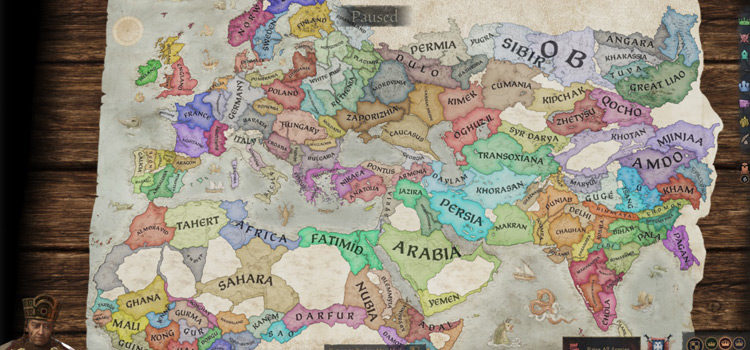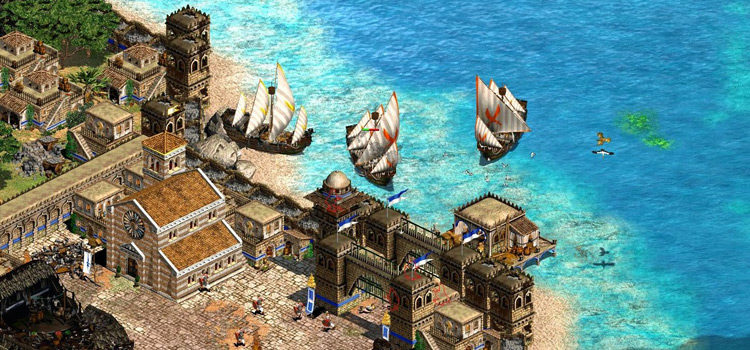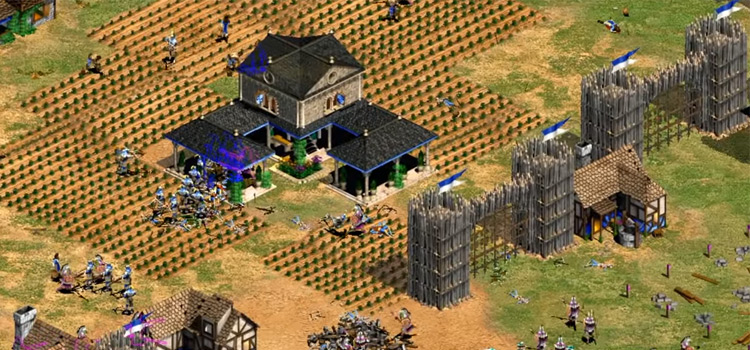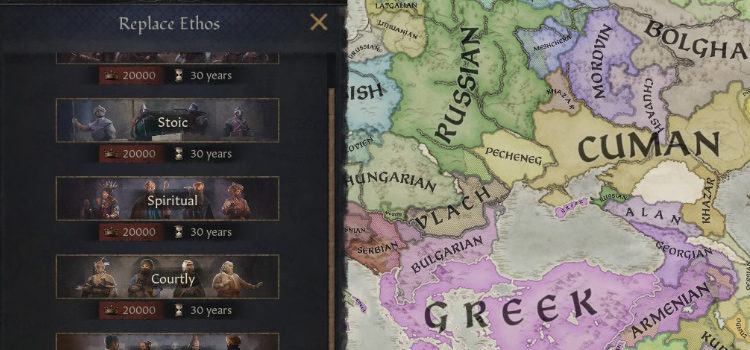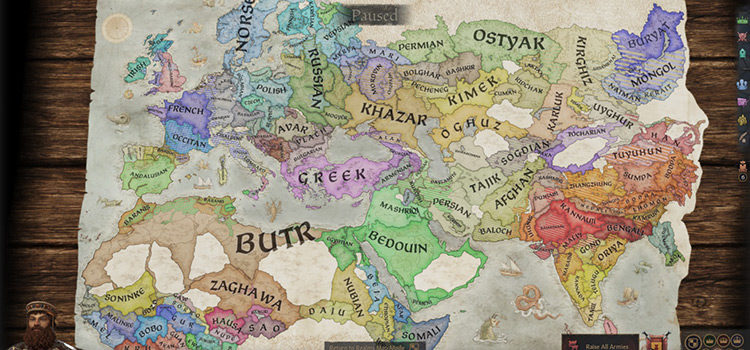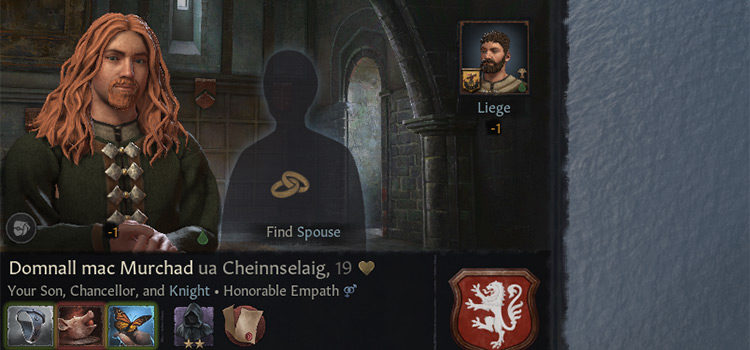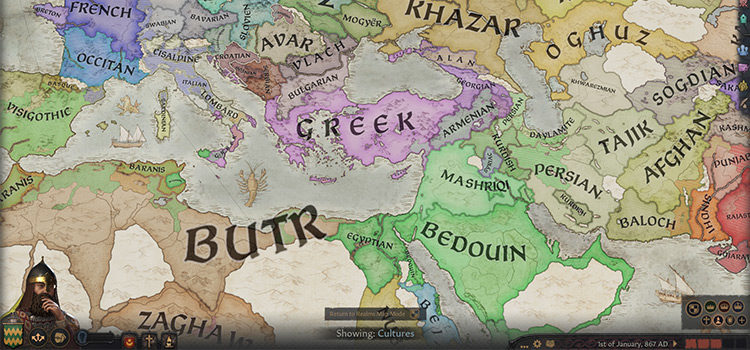The Largest De Jure Empires in CK3, Ranked
This post may contain affiliate links. If you buy something we may get a small commission at no extra cost to you. (Learn more).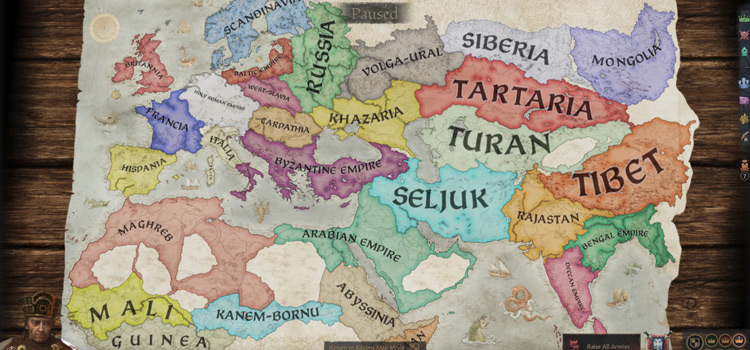
The playable map in Crusader Kings III is split into various de jure entities. De jure essentially means “by law” in Latin.
There are three de jure tiers in CK3: duchies, kingdoms, and empires.
Every county is part of a duchy, which is part of a kingdom, which in turn is part of an empire.
The de jure empires in both starting dates vary wildly in terms of size. Most of them aren’t formed either; you must acquire 80% of the de jure land to create the title.
This ranking will explore the largest empires in the game, using their number of counties as the main metric. The reason for this choice is that if you’re an emperor, expanding your realm is trivial compared to any other case. Counties are what the game cares about when you attempt to claim a title for yourself!
7. Scandinavia
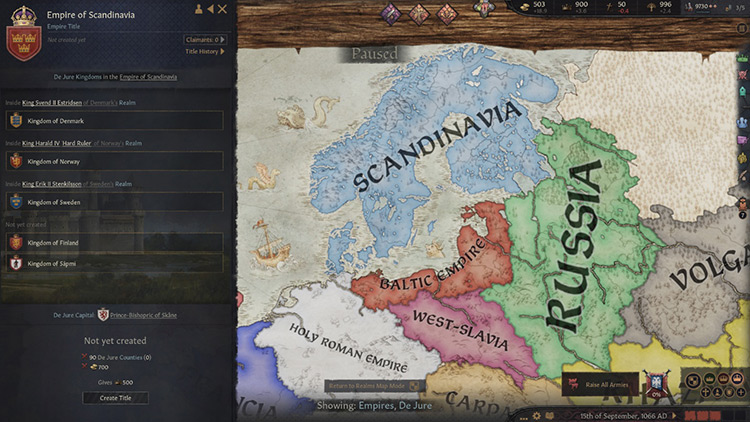
Scandinavia dominates the northernmost part of Europe.
The native land of the Norse and homeland of many Finnic people, Scandinavia totals 112 counties and 5 kingdoms.
It’s one of the least developed regions in the game, solely populated by tribal rulers in 867. For this exact reason, conquering all the necessary land and claiming the title for yourself is far easier than any other title on this list.
There are more special unique buildings than one would expect, spread among the three Norse kingdoms west of the Baltic Sea. The terrain is homogenous, with taiga and mountains to the north, and plains to the south, with a couple of forests and farmlands in the kingdom of Denmark.
With Norse being arguably the most flavorful culture in the game, I recommend a playthrough where you unite their homeland and wreak havoc in Christian Europe from the cold north!
6. Arabia
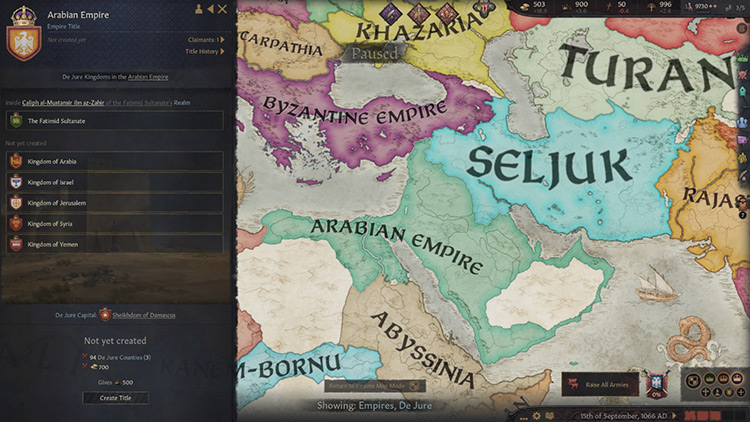
The empire of Arabia is one of the few that are held by a ruler in the 867 start date.
It has 117 counties in total, with 5 kingdoms under its jurisdiction.
Arabia’s land is desert and drylands for the most part, with the floodplains of the Nile River in Egypt being the exception. The native cultures make excellent use of this harsh terrain, with special bonuses in desert and desert mountains.
And with the holy land in its borders, the Arabian empire has no shortage of unique special buildings. From the pyramids in Egypt, to the citadel of Aleppo there are all sorts of unique buildings for you to make use of.
Arabia’s inland provinces are quite undeveloped, with several tribal rulers. The coastal areas, on the other hand, are developed and built up – especially in the 867 starting date.
Forming the empire yourself in 1066 is not the easiest task for sure. The Seljuks dominate the area and they hold a lot of land you will eventually need.
In 867 it might seem easier to usurp the title from the Caliph, but you must keep in mind that he’s the head of faith for most of his vassals. It won’t be easy finding support unless you’re playing with the reduced realm stability game rule! You can always play as the Abbasid caliph of course.
5. Rajastan
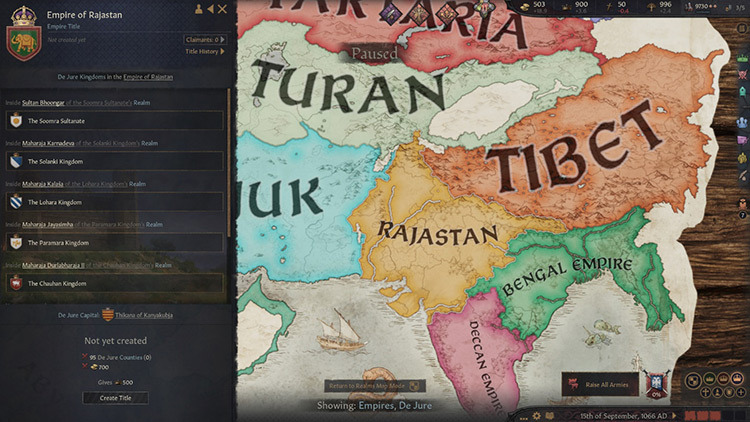
The empire of the Rajput numbers 118 counties – a single county more than Arabia.
Yet its lands include some of the most developed areas in the game. This is true for both starting dates.
With 118 counties split between 9 kingdoms, it’s an empire than can employ vassal kings far easier than Arabia. Vassal kings are usually something you want to avoid, as they are far more unruly.
If you have built a powerful domain for yourself, delegating to vassal kings who can expand the empire themselves is always a good idea. Especially if you follow one of the pacifist faiths native to India.
Rajastan doesn’t have a huge concentration of unique special buildings.
However, it does have 5 out of the 7 Hindu holy sites inside its borders.
Creating the imperial title of Rajastan is easy if you begin as the Pratihara Maharaja in 867.
In general, due to the nature of the native religions of India, it isn’t easy to conquer vast territories in short periods of time. Doing it as a Muslim character is easier, but realm stability will be a problem down the line.
All in all, a quite diverse empire in terms of terrain, and the one with the biggest concentration of farmlands in the entire playable map!
4. Persia
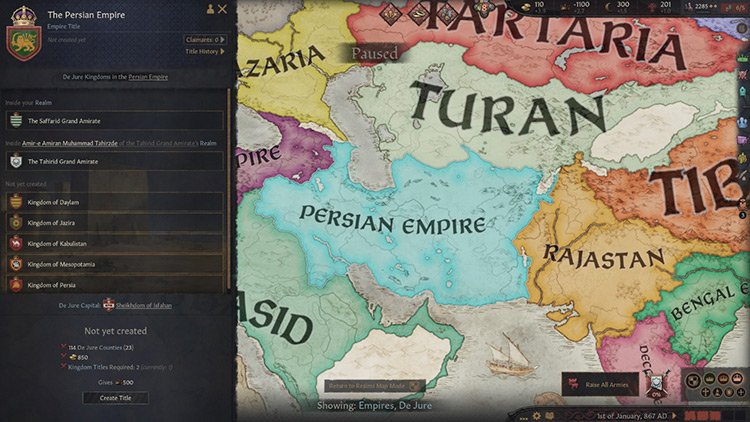
The Persian Empire carries an ancient legacy in its name.
Its 142 counties are a big increase from the last entry. Comprised of 7 kingdoms in total, Persia’s de jure vassal situation is very good for an aspiring emperor wishing to delegate power.
The smaller kingdoms are situated at the empire’s borders. Delegating power to a couple powerful kings can be a good idea. They can expand your realm by conquering weaker neighbors while you concentrate on other matters.
Persia also has a couple unique special buildings to show. There are religious buildings for eastern religions, Muslims, and of course Zoroastrians.
Of course, as the native land of Zoroastrianism, Persia contains all Zoroastrian holy sites.
In 1066, the Seljuk dynasty has the title of the Persian empire and controls most of its lands. Unless playing as the Seljuks, forming the empire is no easy feat.
One very satisfying campaign (and one of my favorite ones since CKII) is playing as a local Zoroastrian ruler. Recreate the empire and drive back the Muslim invaders. The Bavandid dynasty in Tabarestan is even directly related to the old Sassanid Emperors!
3. Holy Roman Empire
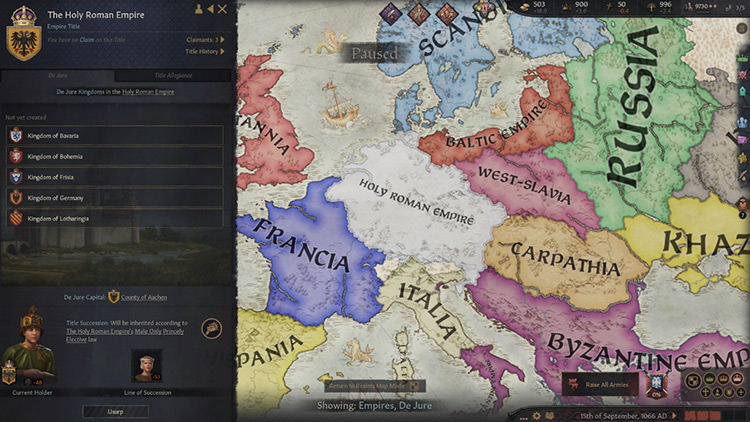
The Holy Roman Empire could not be absent from this list.
It’s a unique case, as it technically has no de jure land in 867. It’s replaced by the empire of Germania, which has the same territory, minus Bohemia.
In 1066 it exists and is held by the Salian dynasty, numbering a total of 172 counties with only 5 kingdoms. On top of that, the kingdom of Germania is by far the largest in the game, and no vassal of yours will ever form it realistically.
The kingdom of Bavaria is also large enough that it won’t be ever formed without your approval. This means that the empire will be mainly comprised of strong dukes, as most duchies in the empire are larger than the average.
The empire also has the special “Princely elective” type of succession. This makes taking control as a vassal a breeze, as by simply being a good ruler you will eventually be elected to the office of emperor.
It’s not uncommon to be elected when you’d prefer to not.
I want to chill as a vassal for once!
The HRE is a definitely unique case though, as you’ll rarely form it by traditional means. You’ll either do it through decision in 867, or by being elected in 1066.
2. Tibet
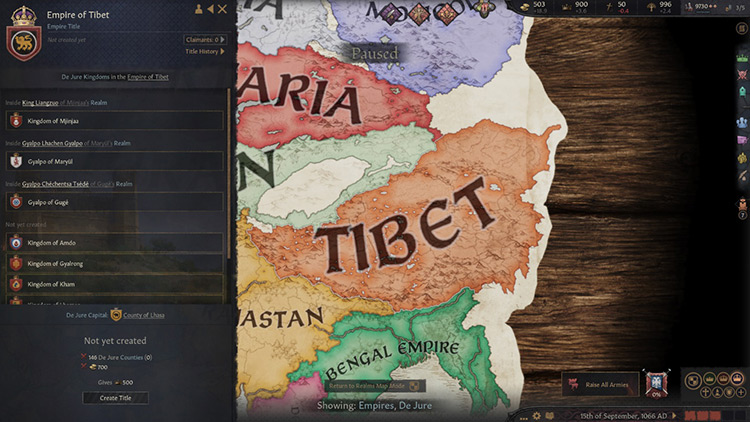
The empire of Tibet isn’t held by anyone in both starting dates.
In 867, the rulers of Gugé and Ü are brothers whose father was the last emperor of Tibet. He died 25 years before the starting date and the empire is since fractured completely.
Tibet has a grand total of 182 counties, split between 9 kingdoms.
Decentralization is the name of the game in this cold and arid plateau. You’ll eventually have to resort to vassal kings at some point.
Forming the empire is certainly not an easy task, either.
The sheer number of counties needed is a huge obstacle.
No starting ruler is dominant, while the confederate partition succession law you are stack with for the early game will split up your realm over time. You can circumvent that, but then you endanger yourself in other ways.
The area is home to a variety of faiths, with the Bön faith and Buddhism dominating the core lands of Tibet. The cultural map of the empire is also homogenous for the most part, with a sharp increase in variety in the northern desert parts.
Forming the empire of Tibet as any member of the Pugyel dynasty will also net you a unique achievement. A campaign as either one of the two Pugyel brothers in 867 is something I recommend doing at least once!
1. Byzantine Empire
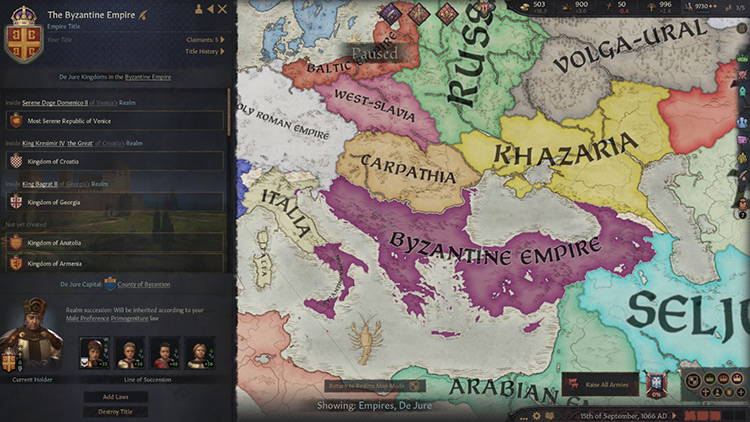
The Eastern Roman empire tops our list here.
The empire exists in both starting dates, so you’ll surely be familiar with its beautiful imperial purple color.
Standing at the crossroads of Europe, Asia, and Africa, the Byzantine empire with its 187 counties and 14 kingdoms dominates the most central part of the map.
Fun fact: all empires listed in this article border each other and form an unbreakable line that splits the entire map in two roughly equal parts. Pretty cool!
The Byzantine empire features far less unique special buildings than one would hope. Outside the capital of Byzantion, the only unique building is the Siderokausia mines in Thessalonica.
Let’s hope the various ancient Greek monuments will be added in a future update.
The Greek culture dominates the core of the empire, with various other cultures at its borderlands. Christianity and mainly Orthodoxy are almost the exclusive religion in the Byzantine lands.
And the Greek culture has some of the most unique traditions in CK3, with many of them tied to the title of the Byzantine Empire.
On top of that, the empire has the primogeniture succession law even in 867, which makes it extremely stable.
Conquering enough land and claiming the title in the traditional way is not something you’ll do in a typical campaign.
Usurping the imperial title is always preferable, especially because you’ll inherit the primogeniture succession law.
And here’s something else noteworthy:
The Byzantine Empire has access to a decision that restores the Roman empire if you control specific duchies. They share this decision with the HRE and a unified Italia.
Restoring the Roman glory as the rightful emperors is always a fun campaign!
